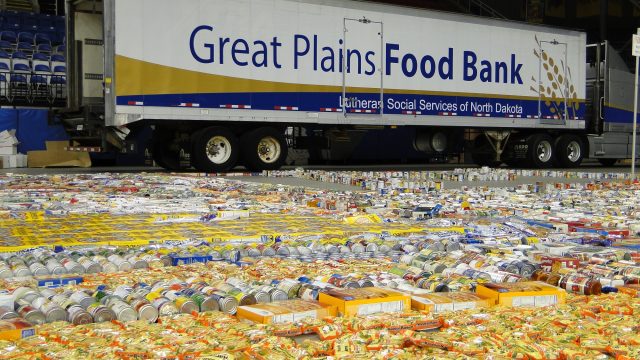60 Percent Of North Dakota Is Struggling To Buy Food? UPDATE: Not So Much

These numbers are a little hard to buy in a state that has lead the nation in personal income growth for six out of the last seven years and just hit a new high for obesity:
Increasing numbers of North Dakotans are making tough choices about whether to spend money on food or on other necessities, according to a study released Thursday by the Great Plains Food Bank in Fargo. …
The 2013 study, which covered North Dakota and Clay County, Minn., showed several upsurges compared with a similar study done in 2009.
- More than 60 percent of households reported choosing between buying food and paying for utilities. That number was nearly 40 percent in 2009.
- More than 60 percent chose between buying food and paying for transportation. In 2009, it was 26 percent.
- More than half chose between buying food and paying for housing. In 2009, the number was more than one-third.
- More than 60 percent chose between buying food and paying for health care. That figure was 31 percent in 2009.
In all, more than 66,700 people in North Dakota and Clay County sought sustenance from food pantries and meal programs last year – a 38 percent jump over 2009 when 48,200 people received help.
The first problem with this study is that it was produced by a network of food banks that no doubt has an interest in promoting the interests of food banks. Portraying hunger as a problem means more donations, more government grants, etc.
If the oil industry put out a study saying we need to pump more oil, people would be skeptical given the source. The same skepticism is warranted with non-profits putting out self-serving studies, how ever noble the goal of those non-profits.
We should be disappointed in groups like this which obscure the real problem with hunger with self-serving public relations.
The second problem is that these numbers just don’t pass the smell test. North Dakota is running at full employment. Opportunities abound. Incomes are rising. The idea that a majority of the state has had to choose between food or paying for heat is patently ridiculous.
Someone is cooking the books on these numbers.
Even if we accept at face value the increase in people who are seeking food from food pantries, how much if that is driven by need and how much is driven by availability? Nationwide we’ve seen an explosion in food stamps enrollments, but that had less to do with need than it did with the expansion of eligibility in the food stamps program.
I wrote about the increase in food stamps enrollments here in North Dakota a year ago. We saw a sharp spike in the 2008/2009 area, but that had everything to do with expanded eligibility, as well as some changes in how the program is administered. This is what Arlene Dura, director of the food stamps program for the State of North Dakota, told me about that:
Instead of reporting monthly to verify income and other household changes, people now report twice a year (unless their income changes and exceeds the program’s limits). Before, people who didn’t get their paperwork in monthly would have their cases closed and their benefits ended or interrupted.
ND also stopped reducing benefits when household income fluctuates or increases (within qualifying income levels). A household’s SNAP benefit remains the same or can increase during the 6-month eligibility period.
This illustrates a problem with programs like these, whether it’s food stamps or food banks. We often allow the number of people participating in the program to be the equivalent of people who need the program. But that’s not really true. Often, if a person is eligible for a program, they’ll sign up whether they need it or not.
Sadly, the people who run these programs don’t really care. More people participating means job security for them, and potentially larger budgets.
UPDATE: As it turns out, contrary to what the Fargo Forum report above states, those samples were clients of food banks, which is information you can find buried in the bottom of the press release.
The Forum report states the figures simply for “households” in ND without identifying that the sample is only food bank clients.
My bad for not going to the source.




